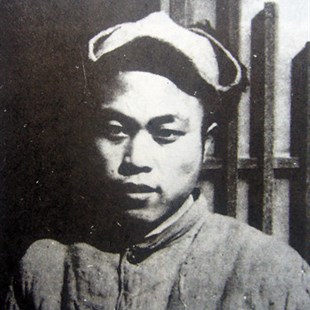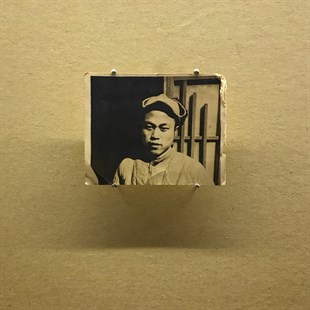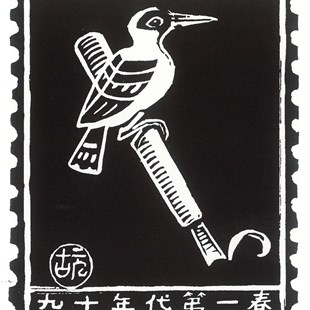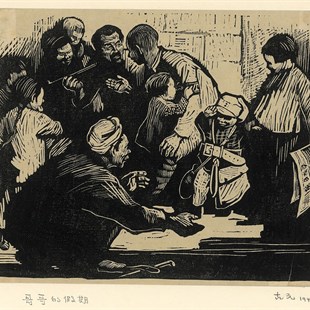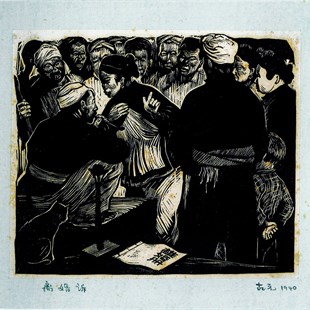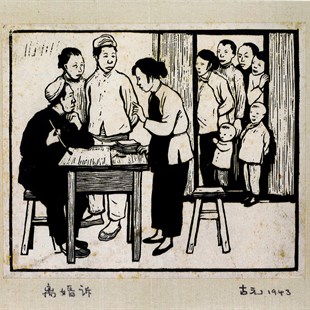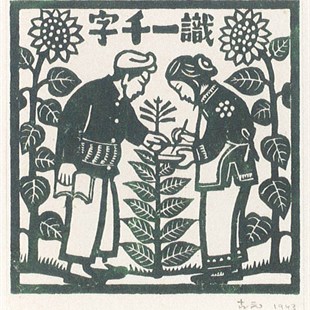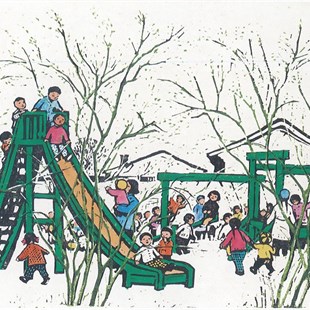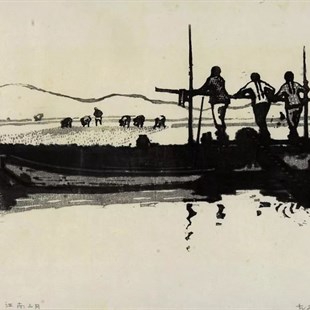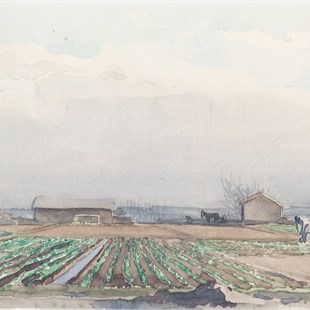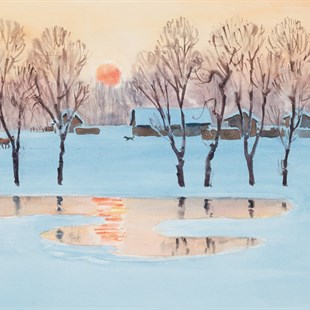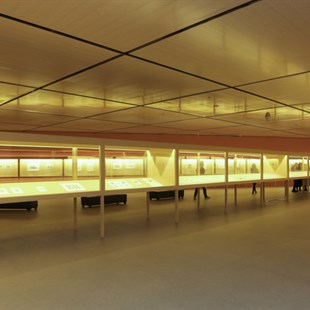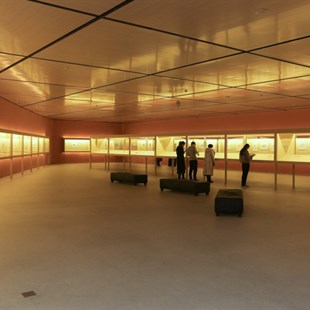
There was a child in Southern China,
He sought truth in Northern Shaanxi.
Unconsciously he was over 70 years old,
This foolish old man is still determined.
—Gu Yuan
On October 16, 2019, the Exhibition Commemorating the Centenary of the People’s Artist Gu Yuan’s Birthday was unveiled at the Art Museum of the Central Academy of Fine Arts. Borrowing the simple “reading column” favored by the public, the exhibition used small magnetic nails to imitate the jujube thorns of the Yan’an period. There are a total of 243 sets of prints, drawings and watercolor paintings by Gu Yuan, as well as documents and historical photographs from family collections, which try to convey an “authentic” artist to the audience. The title of the exhibition is from the calligraphy written by Gu Yuan in his first exhibition in the 1980s. Gu Anchun said: “This exhibition came from the cave dwelling.”
“The very original exhibition of Gu Yuan, started from a cave dwelling.”
“If Mr. Gu Yuan was still alive, how would he present his own exhibition?”
In July 1919, Gu Yuan was born into a returned overseas Chinese family from Panama and they lived in Xiangshan County, Guangdong Province. He liked to paint when he was young, and initially learned to paint figures, animals and landscapes from temple murals. He entered primary school when he was 8 years old, and later he was admitted to the First Middle School of Guangzhou Province. He took watercolor sketching in his spare time and studied with his classmates. In 1937, when the War of Resistance Against Japanese Aggression broke out, Guangzhou suffered an invasion. Gu Yuan did not evacuate to the village together with the teachers and students of the school. Instead, he chose to return to his hometown to serve as a substitute teacher in a primary school. Here he gave play to his first interest and took up brushes to draw salvation posters.
In 1938, the 19-year-old Gu Yuan was attracted by a report on the school situation in Yan’an published by Guangzhou’s “Salvation Daily” and volunteered to study in Yan’an. Later, he recalled: “As soon as I arrived at the Northern Shaanxi Revolutionary Base, I felt that the people were the masters of themselves. The dreams of many years were realized there. Although the material life was quite difficult, the relations between the upper and lower levels, between the military and the civilians, among the comrades, are equal and harmonious. People were full of feelings, hopes and confidence in labor and life. These deeply affected me.” After arriving in Yan’an, he accepted the three-month revolutionary theory study in the Northern Shaanxi Public School and officially entered LuXun Academy of Fine Arts to study woodcut prints.
In 1940, Gu Yuan who graduated from LuXun Academy of Fine Arts, and several graduates from the Department of Literature went to work in Nianzhuang Town, Yan’an County. Here, Gu Yuan spent his spare time drawing literacy pictures for the folks, and used the jujube thorns on the mountain to nail the pictures in front of the cave and let the folks appreciate and study. This is the first time that Gu Yuan’s works were exhibited. “Gu Yuan came out from the cave.” Ms. Gu Anchun, the eldest daughter of the ancient Gu Yuan, said during the introduction of the exhibition: “The idea of this exhibition is to let everyone find a feeling of Yan’an cave in the exhibition, because that’s the taste of Gu Yuan.”
“Why paint, how to paint”
In the Nianzhuang village, Gu Yuan “saw the daily life of the villagers as if he has seen many beautiful pictures.” In the process of contact with the villagers, he found that they liked to paste some of the specific pictures he had distributed on the wall and repeatedly admired them. He began to understand the preferences of the folks for poultry and engraved works like “Cows” and “A Flock of Sheep”. This was the first time he realized the authentic meaning of painting—”why paint and how to paint”, which initiated the way that he became a people’s artist.
According to the daily life of the villagers, Gu Yuan created woodcut works such as “Entering the Warehouse”, “Women Reading the Newspaper” and “Divorce Proceedings” (I). Besides, every time he finished a painting, he printed multiple copies and distributed them to the villagers. He actively revised his creative techniques from the criticisms put forward by the villagers. At a time when the folks expressed their affirmation of his work “Divorce Proceedings” but they pointed out: “why the face is black and white, covered with so many black lines?” For this, he re-engraved a “Divorce Proceedings” (II). “About 1942 was the demarcation point, before that we find that Gu Yuan’s woodcuts were dominated by black.” Wu Hongliang, Curator of the Art Museum of Beijing Fine Art Academy, clearly pointed out Gu Yuan’s prints changed significantly in 1942, “the black style of Gu Yuan” became “white style of Gu Yuan.” “Divorce Proceedings” which was created twice before and after, is a typical representation of the change of Gu Yuan. In 1943, “Divorce Proceedings” (II), the original “black yin and yang face” was almost carved into white, only the black blocks of the main characters’ costume in the picture were retained. The “Reduction of Rent”, created in 1943, and the second engraved print, “The Holiday of Brother”, used the same method of creation and became a classic work of Gu Yuan’s woodcut prints.
Why paint? “If you don’t have the idea of serving the people, you will not be interested in many facets of life. Maybe you are interested, but you may not think the same as folks.” Gu Yuan said, “I always want to present people’s life.” How to paint? “I think of traditional paintings and folk New Year paintings and book illustrations in China. These are the art forms that folks of our country like to see and hear. I think I should learn from the excellent cultural heritage of our country.” After leaving the village Nianzhuang, the creation of Gu Yuan began to draw nutrients from traditional Chinese paper-cuts, New Year pictures and book illustrations, which has brought a new look to his prints, and also enhanced the artistry of the works, from the works such as “Cooperatives” and “Knowledge of One Thousand Words”, spectators can fully understand this.
“I always want to express people’s lives, even if in an indirect way.”
“I often think that before I went to Northern Shaanxi, although I had a strong interest in art, if I had not received the education at the Northern Shaanxi Public School and LuXun Academy of Fine Arts, I could not clearly establish a firm belief in serving the people.” The world view and artistic concept that Gu Yuan has established in Yan’an has profoundly influenced his artistic development. As early as his middle school period, Gu Yuan began to paint watercolors, but was limited by the environment of the time, until the 1950s when he regained this preference. Gu Yuan who lived through the 1930s and 1940s, although his watercolors mostly depict landscapes, they are often decorated with characters. Among these works that seem to be purely depicting the scenery, you will find that there are two or three figures that have been fully integrated into the paintings, such as “Outside the Ancient City” (1953), “Vegetable Garden” (1954), “Sunset after the Snow” (1972) and so on. He once stated: “I always want to express people’s life, even if in an indirect way, I paint some watercolor landscape paintings, to bring some local flavor and show some activities. I rarely draw anything unnatural, pure natural landscape paintings.”
Gu Yuan’s works pay attention to people, although he presents a new social appearance after the founding of the country, he still does not forget the working people. The question is how to express a new look? When some artists used new machines to express the new era, Gu Yuan had his own ideas. For example, in his work “March Time in the South of the Yangtze River”(1956), Gu Yuan portrayed three women who were drowning in the old-fashioned waterwheels. They looked back at the audience, or chatted about the interesting things in the village, or watched their men planting in a paddy field not far away. The harmonious spring landscape in the South of the Yangtze River was depicted on the paper.
In the exhibition hall of the Art Museum of the Central Academy of Fine Arts, Gu Yuan’s works are exhibited in the form of a newspaper column which is most convenient for viewers to see the paintings in the form of mounted original paintings. They are like a description of historical changes of the times and social development. When we want to get something from it, we find that the feelings of the predecessors are unattainable. As the artist Xu Bing said: “I can find this slope from the woodcut of Gu Yuan, but when I try to portray it, once it is transferred, it is not a slope any more.” In 1977 when Xu Bing came to the Central Academy of Fine Arts, he studied the style of Gu Yuan and he tried to engrave his fine-grained situation in memory with woodcuts and received the affirmation of Gu Yuan. However, he found that he could not hold onto anything that he was seeking. At that time, he began to feel that Gu Yuan was incredible. He said: “The woodcut of Gu Yuan is impossible to learn because it is not ‘technical’, but ‘emotional’.”
“The cycle of history allows us to sort out the performance of our predecessors more clearly, but the depth of history has always left a mystery in the plausibility of this cycle, testing people’s weaknesses and shallowness to distinguish sharpness from mediocrity.” What did Gu Yuan leave for us? Looking back at the words Xu Bing said of Gu Yuan’s exhibition, it seems to give us some clues.
Text by Yang Zhonghui, translated by Sue/CAFA ART INFO
Photo of Exhibition View by Hu Sichen/CAFA ART INFO


